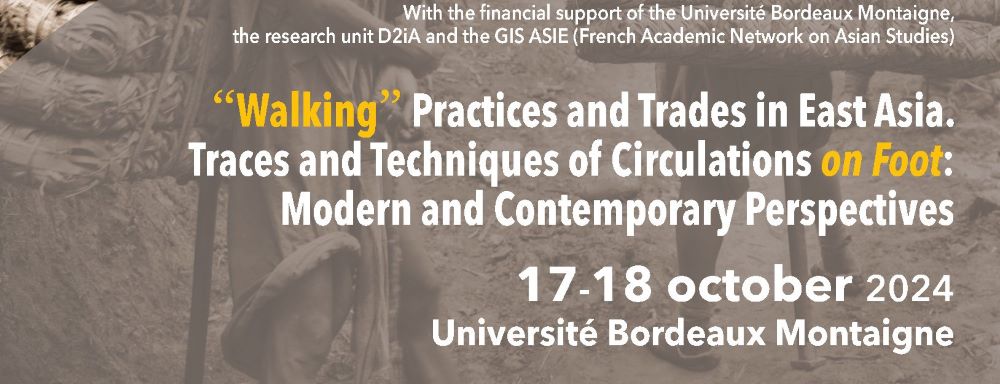
Call for papersUntil the arrival of various modern means of locomotion, there was “no alternative to walking for the vast majority of people”, as tells us Joseph A. Amato. Moving on foot seemed to be a necessity in many situations and, as Antoine de Baecque points out, walking is through time “a continual reinvention of a pedestrian tradition”: from shepherds and pedlars in the Alps to communities of Compagnonnage, from Tuareg caravanners to the Sami, not forgetting certain Native Americans such as the Sioux, there are peoples, practices and trades “whose very identity is pedestrian”. What about East Asia, where, depending on the region, it took a relatively long time to modernise certain modes of transport? To what extent did this human “animal machine” made for the terrestrial locomotion, as described by the physiologist Étienne-Jules Marey, play a part in weaving the remarkable Est-Asian network, perhaps more often than we think by treading on paths, roads and tracks? The contributions will, of course, take into consideration the essential participation of pack animals in human mobility. But, for example, until the end of the Chinese empire and even until the mid-20th century, camels, mules and horses carried not so much people as their belongings across mountainous, steppe and desert terrain, but also through urban areas. To take a different example, Bashō, the traveller on the well-trodden and ill-frequented Tōkaidō road, invites us in his poems of the 17th century “not to ride a horse, but to walk leaning on your stick”. How can the study of space, itineraries and stopovers (caravanserais, inns, refuges) also serve as clues, traces and landmarks to counter certain clichés or paradigms that need to be revised, particularly in terms of territoriality and responses – often local and non-state, especially in borderlands and remote places – to security problems? This resolutely interdisciplinary conference aims to follow in the footsteps of East Asian “walkers” and revisit the science, or art, of pedestrian travel on the eve of major modernisation processes. We will explore the social and technical dimensions of the many forms of “walking”, some of which were decisive in the functioning of societies, in supplying towns and remote places. The aim is to (re)see the extent to which the ways and reasons for moving have become more complex through an impressive diversity of phenomena, in which social categories, practices and trades have been confused, intertwined or, on the contrary, opposed: sedentary and nomadic, warlike and brigandage, commercial and migratory, exploratory and colonial, exodus and exile, pilgrim and processional. At the turn of the twentieth century, walking lost some of its “professionals”, but took on a powerful symbolic dimension, with political marches (the Long March), protest marches and anti-colonial marches (the Salt March), inspiring today’s “demonstrations”. Not forgetting the etymology of hike (randon), translated differently in Asian languages, but etymologically referring to the act of chasing down an animal on foot. From this diachronic perspective, we cannot fail to ask the very broad question of how the various Asian societies of yesterday and today “walk”, both literally and figuratively. In the spirit of continuing a dynamic already well underway and generously endowed with detailed observations of Asian trading, nomadic and herding peoples, this colloquium is structured around two axes: traces and techniques. The aim will be to shed light on small and large-scale movements in the light of the most banal, everyday aspects of various pedestrian social lives: they will be captured “at ground level” as we say in microhistory. Such an approach should invite us to reflect on the practices of individuals, the social composition and internal organisation of communities, and by the same the way in which they are organised around a pedestrian “set of techniques”, i.e., “acts traditionally held to be effective” in the sense understood by Marcel Mauss in his work on bodily techniques. Additional attention will also be paid to the material culture relating to the various phenomena of walking. The focus will be on Korea, Japan, Mongolia, Taiwan, China and its western margins, Tibet and Xinjiang. Comparative contributions from India, Central Asia and South-East Asia, including Indonesia, Thailand and Vietnam, Cambodia and Laos, will also be welcome. Shepherds, caravanners, smugglers, brigands, escorts, hunters, brokers, peddlers, postmen, coolies, pilgrims, Jesuit missionaries, soldiers, mercenaries, pioneers, scientists, explorers, charlatans, acrobats, itinerant craftsmen and artists, porters on chairs and palanquins, sherpa porters and guides, and many others, will be among the groups and practices to be discussed.
How to submit proposals: Participants are invited to propose qualitative studies (in French or English) in history, anthropology, sociology, philology, geography and archaeology, covering, without limitations, the modern (approx. 15th-20th century) and contemporary (20th century to the present day) periods. Comparative contributions with extra-Asian regions and/or earlier periods will also be welcome. Proposals should be accompanied by a title, a summary (500 words maximum) and a short bio. Abstracts will be read as they are received, so that participants can plan their visit to Bordeaux well in advance. We invite you to send your proposals for contributions by Friday 31 May 2024 to the following address: laurent.chircop-reyes@u-bordeaux-montaigne.fr
Scientific and educational expectations: The conference is planning an international call for papers. Papers may be presented in either French or English. The event is committed to inviting students (Bachelor's and Master's degrees). Presentations by young researchers (doctoral candidates and post-doctoral fellows), as well as their involvement in moderating the panels, will be very welcome. A publication project in the form of a collective book (bilingual French/English) is envisaged with the Presses Universitaires de Bordeaux by 2025. Call for panels: Proposals for panels are encouraged, particularly in the following areas:
|

